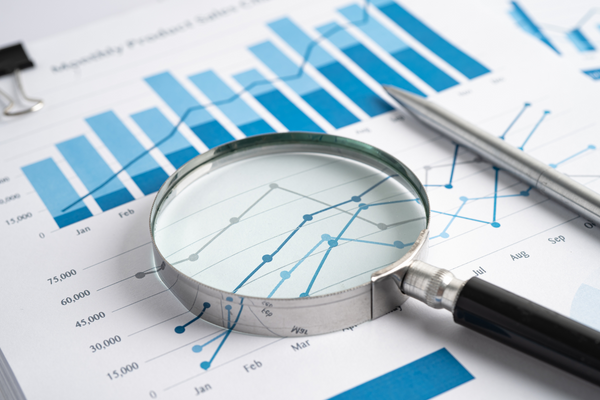
Data is often dubbed the “new gold” in today’s digital era. More than 80% of businesses use data discovery to get unique insights and make more informed decisions.
However, there are requirements for data discovery analysis, and just because you may be analyzing certain business data sets doesn’t mean you’re doing data discovery analysis right.
In this article, we’ll cover key components and approaches to implementing data discovery analysis, dealing with sensitive data, and streamlining data discovery analysis using futuristic technology.
So, let’s get into it!
Key Takeaways
Data discovery analysis can help businesses extract valuable information from raw data for better data-driven decision-making.
The data discovery analysis process can be descriptive, help solve a business problem, explore new ideas, or help predict future trends.
Data discovery analysis tools can help automate the discovery process, but you’ll need to ensure it’s in line with data privacy regulations and your internal data compliance framework.
Exploring Data Discovery Analysis
Mastering Data Discovery Analysis Gathering Insights From Your Data (6).png

Before we look into the methods and components of data discovery analysis, let’s first define it clearly. The purpose of data discovery is to generate insights from business data and present it in a way that’s clear and easy for non-technical individuals to understand.
So, does analyzing a certain part of your organization’s data come under data discovery analysis? Not really.
Data discovery analysis is a process that covers business data as a whole. For this, you’ll need to define data sets, create parameters for the analysis, and understand which data variables will be analyzed.
More importantly, you’ll need to know what goals you wish to achieve from the process.
So, we can define data discovery analysis as the process of simplifying, grouping, and analyzing business data to gain valuable business insights.
The Depths of Data Exploration
For most businesses, data discovery analysis involves more than simply compiling data sets on Excel sheets. Nowadays, data discovery is done through complex software with the ability for real-time data analysis.
Let’s assume you’re a medium-sized digital company that collects data on all consumers. This could easily translate to thousands or even millions of variables.
But how can you recognize sensitive data from the sea of variables? More importantly, how do you extract unique insights on sensitive data if you don’t know where they’re located?
This is where the depth of data discovery analysis comes in. Most modern tools can analyze one of several variables, compare thousands of unique data sets, and extract insights according to set parameters – in real time!
For modern businesses, data is power. And businesses that get more accurate insights in less time have a competitive advantage.
Now let’s go back to the example of a mid-sized business. Assuming you’re dealing with thousands of data sets, imagine you could get unique insights into consumer behavior and buying patterns much faster than your competitors. The potential of exploring uncharted data territories is endless with the right data discovery analysis approach.
Components of Data Discovery Analysis
Mastering Data Discovery Analysis Gathering Insights From Your Data (7).png

Having data discovery tools for analysis is great, but there’s a lot to know before you can implement one in your business. Let’s start by looking at the components of data discovery analysis.
These components can be broken into data mining techniques, visualization, and predictive analysis.
Let’s explore each separately:
Data Mining Techniques
Data mining involves analyzing large data sets to extract unique information. It’s the first step of data discovery analysis and often involves defining and extracting variables from raw data. We won’t look too closely at the actual statistical data mining techniques, and there’s no need to learn them yourself!
However, it’s important to know how data mining works and how it helps extract knowledge from raw data.
Let’s say you have a large database containing information on consumer purchases in the past year. Sure, you can probably figure out how much revenue your business generated or how many sales you’ve had.
But what about more unique insights? Like figuring out how likely it is for a certain gender to buy a certain product on a specific day? This is where data mining techniques come in. They help identify patterns and trends in raw data, and the best data mining software can do it with millions of variables.
Advanced Data Visualization
Once you have specific information from raw data, you’ll need to present it in a way that’s easy to understand. This brings us to the second part of data discovery analysis – data visualization.
Data visualization helps present complex data to help simplify the decision-making process. There’s no way the average marketer is going to understand complex sequential patterns from data mining! However, when the data is presented graphically, it becomes more practical for decision-making.
Many data discovery tools have interactive dashboards that allow businesses to easily identify data patterns without needing much technical expertise.
Predictive Analysis
The first two components of data discovery analysis were related to deriving patterns from current data. However, data discovery can also help you predict future patterns through predictive analysis.
This includes anticipating future outcomes and implementing data-driven forecasting. If you’re a manufacturing firm, this can help you manage inventory more accurately, improve order fulfillment, and avoid stockouts.
For service-based businesses, predictive analysis can help forecast demand and anticipate market trends.
Data Discovery Analysis Approaches
Mastering Data Discovery Analysis Gathering Insights From Your Data (8).png

Now that we’re clear on the methods of data discovery analysis, let’s look at some approaches used in this process. Each approach is linked to a certain goal, and it’s important to note that businesses will implement multiple approaches using advanced data analysis tools.
Here are some data discovery analysis approaches to consider:
Descriptive Analysis
Descriptive analysis is a basic data analysis technique and you’re probably already using it for your business. This process involves summarizing data characteristics and using past data to identify trends.
For example, you can use descriptive analysis to calculate the average revenue per customer, yearly growth, and other data relationships. It’s a fairly simple process and even basic data analysis tools can do most descriptive analysis tasks.
The descriptive analysis approach is useful for profiling data attributes which you can then use to profile data attributes. However, you can’t solely rely on this process for data discovery as it’s limited to present and historical data.
Diagnostic Analysis
Descriptive analysis is a useful approach for analyzing data attributes and summarizing data characteristics. But what if you’re looking for potential issues or anomalies in the data?
In that case, try using the diagnostic analysis approach.
Diagnostic analysis allows you to determine “why” a certain event occurred. Let’s say you’re doing data mapping, and some data doesn’t fit anywhere. Or do you find anomalies between data in your compliance framework and accountability framework?
Using a diagnostic analysis approach, you can investigate the root causes of these issues and work to fix them.
Predictive Analysis
Now that we’ve covered analysis strategies that can help classify and determine relationships between current data, let’s move onto more practical analysis techniques. Predictive analysis can get you insights regarding future trends and patterns based on historical data patterns.
The key is to build predictive models that give you a competitive advantage over businesses that may be only relying on simple data discovery methods.
Most modern sensitive data discovery tools do predictive analysis with data mining, artificial intelligence, and statistical models. However, it’s important to implement this using data in accordance with corporate compliance and data security regulations.
This could include asking permission for cookie data, avoiding shady data mining techniques, and following an accountability framework for processing unstructured data.
Prescriptive Analysis
As the name suggests, prescriptive analysis “prescribes” solutions using data discovery tools. Think of this process as the “crux” of the data discovery analysis process. The prescriptive analysis technique uses all three techniques to recommend actions and optimize the decision-making process.
Your business may filter raw sensitive data through data profiling, identify potential issues through diagnostic analysis, and predict future patterns through predictive analysis. You can then use this information to get recommended actions through prescriptive analysis.
So, how do you implement these techniques, especially if you’re dealing with thousands or millions of data sets? It’s simple- use a data discovery analytics tool!
Let’s explore how to implement these tools effectively.
Implementing Data Discovery Analysis
Dealing with Big Data can be daunting, but it’s not like you have to compile and organize everything manually. However, implementing data discovery analysis involves more than simply choosing a tool.
You’ll need to choose the right tool, implement data source integration properly, and ensure that sensitive data is handled according to data security and compliance regulations.
Let’s explore each step in detail:
Leveraging Advanced Analytics Tools
In today’s age of advanced analytics tools, manual data analytics and tools like Excel are a thing of the past. Analytics tools like Informatica and Osano have AI integrations that can not only classify data sets but also do predictive analysis to forecast future patterns.
Some advanced machine learning integrations can even predict future patterns based on incomplete datasets- something that’s almost impossible in manual data discovery.
So, yes, the tools are there and all you need is to choose the right one. But, before doing so, you’ll have to lay the groundwork with data source integration.
Which brings us to the next requirement of implementing data discovery analysis:
Data Source Integration
If your business collects data for decision-making, which virtually all businesses do, you’ll probably have multiple data sources to classify. This could be hundreds or even thousands of sources, and you’ll need to know which ones are important for analysis beforehand.
Fortunately, most tools can access data from diverse repositories, classify them according to set parameters, and convert unstructured data into information for more accurate decision-making.
Some tools, like IBM InfoSphere, are powerful enough to give you real-time data analysis for more accuracy.
Data Security and Compliance
Data discovery analysis will inevitably involve processing sensitive data. Think of consumer emails, purchase behavior, phone numbers, and other sensitive data. This means your business will have to follow data security and compliance regulations.
If you’re using data protection compliance services, they will probably cover the data discovery process as well. This includes creating protocols to handle sensitive data, classifying data correctly, and establishing rules on which data your business can collect.
At Captain Compliance, we ensure your business remains compliant with data regulations throughout the data discovery and data mapping processes. We’ll do regular data audits and help you establish a data compliance framework to ensure compliance with GDPR, CCPA, and other data regulations. Our compliance services also ensure your business covers the best practices for data discovery analysis. But first, let’s explore these best practices in detail.
Best Practices for Data Discovery Analysis
Mastering Data Discovery Analysis Gathering Insights From Your Data (9).png

Data discovery analysis may be automated, but you’ll still have to create a strategy, ensure the analysis is in line with the strategy, and implement the process across different teams.
Here are some best practices to follow for data discovery analysis:
Data Strategy Alignment
Most businesses have data frameworks that cover how data is stored, managed, and processed. Yes, it’s a regulatory requirement, but your business should also have an internal data strategy and frameworks that cover how different departments manage business data.
When doing data discovery, it’s important to ensure the process follows the overall data strategy. This should answer questions like:
What data sets will be analyzed?
What purpose do you want to achieve through data analysis?
How should the data analysis tool process sensitive data?
By having a solid data framework, and ensuring the data discovery process is aligned, you’ll be able to generate faster insights, without compromising consumer-sensitive data.
Skill Development and Continuous Learning
Do you know that there was a time when manual data discovery using Excel was a novel skill? Now, it’s integrating machine learning tools into the data analysis process. In the future, a new “tool” may be released, requiring organizations to adapt again.
It’s clear that without a focus on skill development and continuous learning, your business risks falling behind.
Collaboration and Cross-Functional Teams
According to a study by Bit AI, “86% of employees and executives cite lack of collaboration or ineffective communication for workplace failures”. There’s no point in introducing a new data discovery tool if there’s no collaboration between departments.
Again, this points towards the importance of training and a focus on continuous improvement.
Ethical Data Analysis and Responsible Insights Generation
Ethical data analysis used to be voluntary, but now following data discovery analysis ethics is part of data regulations. Try to follow basic ethical data analysis practices such as:
Ensure fairness and transparency in data collection.
Only use data for the purpose for which you have permission.
Never share data analysis with third parties without permission.
Practice data minimization to reduce the risk of breaches.
Most data privacy regulations will cover these ethics, but it’s worth implementing them in your internal framework as well.
The Future of Data Discovery Analysis
With data becoming more important in decision-making, it helps to stay informed of changes to ensure your business adapts quickly.
The future of data discovery analysis lies in faster, more accurate insights. With current AI technology, you can even get predictability analysis on incomplete data sets. Imagine getting future insights on data that hasn’t yet been recorded!
Data is also becoming more decentralized, and businesses will have to scan more data sources and strive for real-time analysis, all while ensuring compliance with data regulations.
The good news is that the technology is also adapting, so there are always tools to help you get accurate and automated insights.
Final Thoughts
Having a data framework and the right tools can ensure accurate data discovery analysis for better decision-making. However, following data discovery best practices and ensuring regulatory compliance is the tricky part of this process.
At Captain Compliance, we have experts who help you choose and implement the right data analysis tools to automate the data discovery analysis process. Our compliance experts also ensure that your business’s data frameworks are in line with regulations, so you’ll always be a step ahead.
Check out our data compliance solutions today!
FAQs
What is the Data Discovery Process?
The data discovery process involves classifying data from different sources, analyzing the data according to set parameters, extracting valuable insights from the analysis, and presenting it in an easily understandable way.
Read more on revolutionizing data discovery in the digital age.
What is Data Discovery Scanning?
Data discovery scanning involves looking through different data sources to extract valuable information. It’s the first step to getting valuable insights from raw and unstructured data.
Explore compliance solutions for managing data.
What is the Difference Between Data Search and Data Discovery?
Data search involves looking for specific data that you already know to exist. Data discovery involves looking through unfiltered data for data that can be useful in decision-making. Data discovery can, therefore, help “discover” data insights.
Learn more about the data discovery process and what it involves.
What are the 4 Types of Data Discovery Analysis?
The 4 types of data discovery analysis include diagnostic, prescriptive, descriptive, and predictive data analytics. Diagnostic, prescriptive, and predictive analytics can help with decision-making and data-driven decisions, while descriptive data analytics is useful in data mapping.
Learn more about how data mapping works.
What is a Data Discovery Tool?
Data discovery tools help scan various data sources, classify them according to set parameters, and extract valuable information from the raw data. Some tools are more advanced, allowing for real-time data insights.